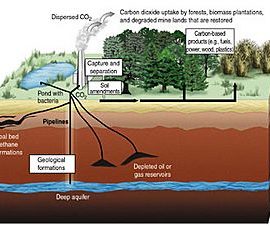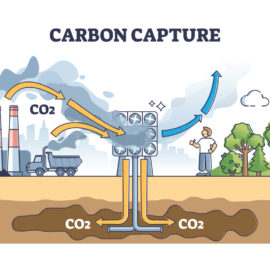
What will carbon capture do and how will it impact crabbing. Some crabbers are leaving as they are not sure.
Crabbing is in Laramie Hill’s blood. Every morning, he boards his boat, the Staffer’s Legacy, and seeks crabs along the bottom of Lake Maurepas as they migrate to and from Lake Pontchartrain every season. He’s the third in his family line to take up the business and has honed his craft for more than half his 40 years. The crabs Hill and fellow fishermen hope to harvest are vital to the seafood industry, selling as far north as Maryland. This year, though, his business is taking a hit. Hill has pulled 800 traps out of Lake Maurepas, concerned that a global gas supply company may harm equipment and wildlife as it prepares to build the infrastructure necessary to store carbon beneath the lake. “I’ve never had to go through anything like this,” Hill said. “I hope and pray if they’re going to do it, and we can’t do anything to stop it… I just hope and pray nothing bad happens. I can’t see myself doing anything else.”
nola.com
They know what the oil industry did and so that is their basis of thought when construction is planned. They may not be wrong.
Fishers and crabbers who have worked Lake Maurepas for decades fear the project will negatively impact the local economy. Air Products plans to build a hydrogen manufacturing plant in Ascension Parish by 2026 that will compress its carbon emissions and transport them via pipeline to below the lake. It is seeking Class VI permits from the U.S. Environmental Protection Agency, which requires them to perform preliminary work including seismographic surveys and construction of two Class V injection wells. At several informational meetings across Livingston, St. John the Baptist and Tangipahoa parishes, Air Products representatives are often berated by those who feel the company is encroaching upon the lake. Lake Maurepas hosts a plethora of wildlife — it’s an estuary for crabs, shrimp and catfish. It houses Rangia clams that filter the water and eagles who hunt fish to feed their newborns. There’s even an occasional manatee. The blue crabs make their way into Lake Maurepas each autumn so they can nestle under the mud, mate and hibernate through the winter before heading back to Lake Pontchartrain in the spring.
It is not just what is there now, but the migration paths.
John Hoover, 55, worries that Air Products’ seismic testing scheduled for the coming months — which will be conducted by Exodaus, Inc. over the course of six months — will harm the crabs or cause them to shift their typical migration patterns. “How is it going to affect the crab migration that’s going on right now?” asked Hoover, who has worked Lake Maurepas for three decades. “Are they going to turn around and bolt out of there and go back into Pontchartrain? Are they going to burrow down in the mud when all these explosions begin to take place? What effect is it going to have?” Air Products says it wouldn’t have received permits to more forward if wildlife was in danger. “Air Products has taken extreme care to avoid impacts to the health and safety of the lake environment, its users, and its wildlife,” spokesman Arthur George III said. The Louisiana Department of Wildlife and Fisheries, who approved the permit for the seismographic survey, echoed this sentiment. Kyle Balkum, the agency’s biologist director, said the project’s boring holes and charges will cause “little disturbance to the water bottoms,” including to Rangia clams. “LDWF has been monitoring seismic activity all along our coast for more than 60 years and has no reason to believe it causes a problem,” Balkum said. “The technique of detonating relatively small charges below the lake bottom, in this case 60 feet below the bed of Lake Maurepas, is not an issue for crabs, shrimp, and fish.”
You never know what will happen when all you get is words saying there will be no damage. Do I have a bridge to sell you?
The agency has also placed restrictions on when and where seismic activity will take place depending on area wildlife, like keeping work away from Bald Eagle nests and ceasing activity if a manatee is nearby. The work will be done before the spring shrimp season, LDWF said. Air Products representatives acknowledged during a three-hour informational meeting in Ponchatoula last month that its project would have some impact on wetlands. “I promise you that our goal is to mitigate our impacts and do better,” Kim Goslin, the Air Products permitting manager, told the room. The company has partnered with researchers at Southeastern Louisiana University to implement an independent monitoring system that will make data like marine life populations and water quality available to the public online. Air Products also plans to work with the university to add artificial reefs to the injection wells in order to bolster aquatic life. But the public aren’t yet ready to embrace the work, being all too familiar with other industrial corporations harming residents or their property. They cite the methane-spewing sinkhole in Bayou Corne that erupted from a salt dome mine as the result of three companies ignoring decades of warnings about potential disaster. Dozens of residents were forced to sell their property.
The Governor lauds Carbon Capture but the effect of the drilling is unknown.
Gov. John Bel Edwards, who is from Tangipahoa Parish, has lauded carbon capture technology as a safe means of fighting climate change. “The only people who want you here are politicians that have no vested interest in the area,” Amanda Bull, a Manchac resident, told Air Products representatives during the Ponchatoula meeting. “The reason for that is because you’re coming in here and you want to use our lake as your litter box… it’s not cool and we’re all mad about it.” Hill said each of his crab traps run upward of $70 once rigged, and should a large number go missing or get damaged, crabbers risk losing upwards of thousands of dollars — enough to ruin an entire business. For that reason, he’s shifting his focus to Lake Pontchartrain, where he may have to compete for space in the more crab-heavy areas. He’ll perhaps return to Lake Maurepas, but only after the seismic testing is complete. “I’d rather have all my gear out of here and let them do their survey,” Hill said. Hoover pulled about 200 traps as well out of the areas Air Products will work heavily in, but is leaving some behind to get a gauge on what impact Air Products’ work will have. “I want to monitor for myself, with all my years of experience with blue crab migration and whatnot,” Hoover said. “I want to have gear on the ground when all this takes place so I can monitor myself what reactions the blue crab population is going to have to all these implosions going on in the lake.”
Already there has been damage – from the waterborne traffic.
Several barges tied to the testing have come through the lake and already uprooted some traps, according to Hoover. Air Products met with about 50 local fishers Oct. 25 to discuss that and other concerns, and the company promised to pay for traps they may accidentally damage in the process. Since then, a reporting system has been set up on its Facebook page, but neither Hill nor Hoover have relaxed. “There’s nothing we can do to stop it, it seems like,” Hill said. “It’s getting aggravating. It’s like they’re having these meetings to talk us down. They want us to back down by dragging it out.”
It is not just crabbers as the lake is used for recreation.
Fears about their own business aside, the fishers worry for the safety of the recreational boaters and vacationers they’ve operated alongside for decades. Once the project is complete, the lake will be scattered with 12 to 16 injection wells, which may sit up to 20 feet above the lake’s surface, according to George. Without the sophisticated tracking technology a commercial fisher’s boat may have, the only indicator boaters will have that a well is nearby at night will be a light, which Hoover worries could fizzle out or get covered by debris, leaving boaters unaware that a giant metal structure could be right in front of them. “Here comes along a boater, either at night or early in the morning and doesn’t see this platform sitting in the lake,” Hoover pointed out. “You’re going to have a fatality or multiple fatalities out there. That’s a very scary situation.” In the long-term, changes made to the lake’s ecosystem aren’t ones that can be reversed overnight, warned James Forstall, a Manchac resident who’s fished on the lake for 30 years with his wife Jody. It’s what fuels the local fishermen’s push against letting the company into the lake — they’ve seen the long-lasting negative impacts large corporations have left on the seafood industry, like in the Deepwater Horizon oil spill of 2010. “This is some of the best shrimp and some of the best shrimp and crabs you can get,” Forstall said. “If they come in here and do something that causes something to go not right, then if you can’t sell this stuff no more you ruin it for everybody. “All it takes is one mistake.”
This is a not in my backyard but when your backyard is a lake with wetlands, maybe that is a good argument.



